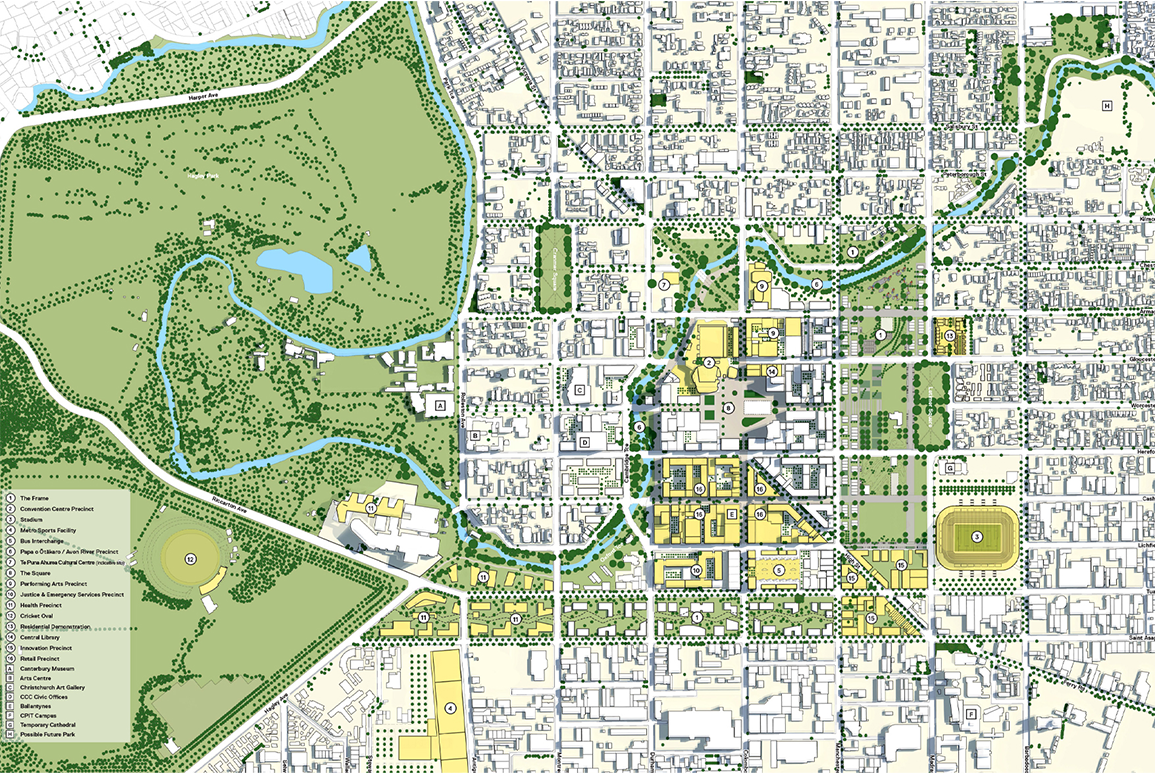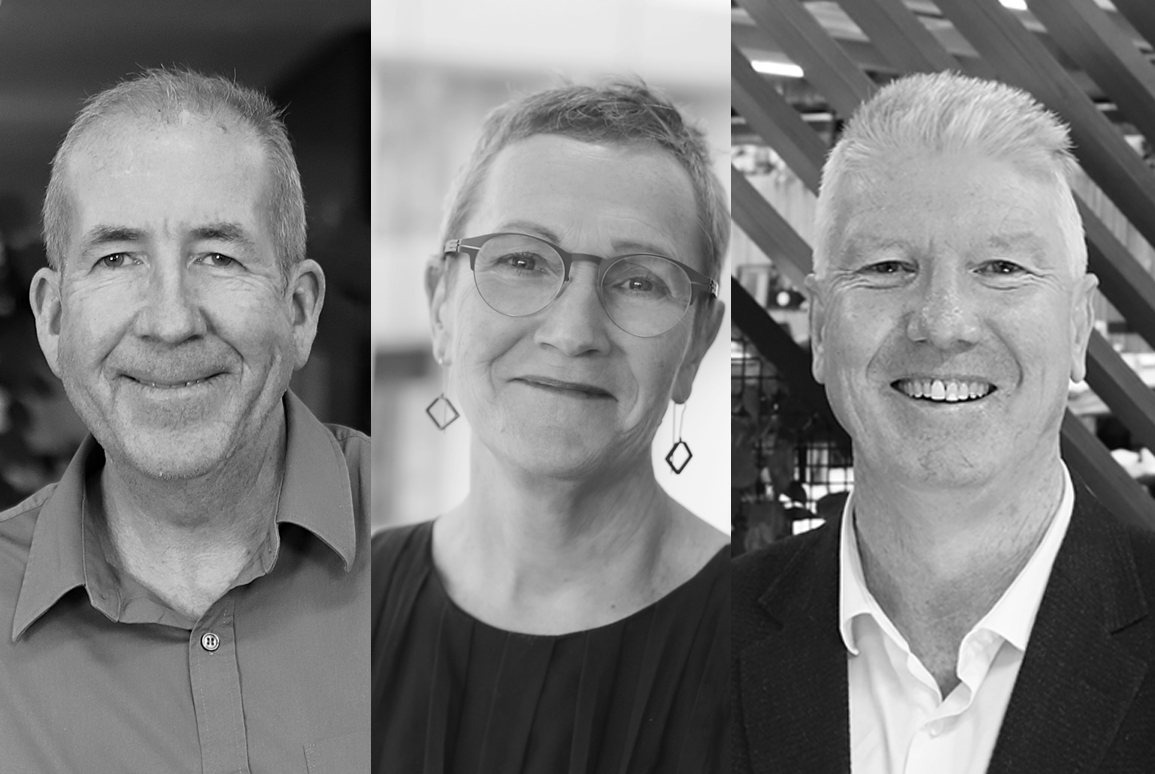Then and now: The Christchurch Blueprint (2012) Part 1
28 July 2022
A New Zealand landscape architecture consultancy leading this significant, high-profile spatial masterplanning project was a milestone for the profession. In the first of a two-part series, Marc Baily, Rachel de Lambert and Ken Gimblett share their memories of those 100 Days.

Q: How do you remember feeling at the end of the 100 Days process in 2012, with the outcome of this blueprint and the direction that it set?
Rachel de Lambert: I know I often felt overawed by the responsibility at the time. I hadn’t lived through the earthquakes (although we did experience some during the 100 Days), but I grew up in Christchurch, and my family had. Some had homes that would be written off, and others just had a bloody great mess (upended commercial kitchen pantries) but practically no damage.
So, for me, being part of the Blueprint 100 Consortium was an amazing opportunity to do something important for my ‘born and bred’ home. It was compelling. I think a key thing was that the dramatic circumstances enabled a boldness that is hard to achieve in normal times. During those 100 days, we absolutely had to be bold.
Marc Baily: Exhausted, proud and connected. Exhausted from the long days and nights to sustain the rightful expectations of the people of Christchurch (and, in fact, all of New Zealand) to see a plan. We carried that responsibility for all of that time, and we probably still do as the city continues to rebuild.
Proud that we delivered a plan that had clear objectives, and set a structure that would deal with some issues Christchurch had before the quakes, as well as setting the city up to grow into itself, and make Christchurch into a place that maintained and amplified its essential spatial structure, but added more opportunities to make it better for people.
I felt connected to Christchurch in ways I hadn’t before. I'm not from there, but now I feel some connection to the place and seeing how it's growing. Most especially I felt connected to the people that were involved in the work. The trust and reliance on each other to do our bit, the long hours and inevitable tensions and debates which rightly occur in the design process, has established bonds with those people that will be with me for a long time to come. Working alongside Don Miskell and Rachel, as well as Ken and others in the senior team, was a special part of that connectedness.
Ken Gimblett: My contribution was a little different to those in the design consortia. I was focused on how to set a regulatory framework to deliver the Blueprint and wider recovery outcomes. That said, we were working in the same office and in combination with each other throughout, as was necessary to deliver for the government and meet our common deadline.
My feelings at the completion of the task are pretty vivid. Firstly, a sense of immense relief. It was a massive effort, under incredible pressure to deliver, and working in very unique circumstances. The work was challenging and unprecedented.
But we often overlook the fact that the earthquake sequence had not finished. We were still experiencing frequent aftershocks; and for those of us who were local, our own houses and lives in general were still pretty much in disarray. That said, I’m grateful the government didn't bring in a team entirely made up of “outsiders”, but instead a combination, to complete the work. Relief and gratitude were front of mind.
The other feelings were a combination of incredible pride in the work we had done, mixed with some trepidation, as we knew much would rely on the direction we had set for a recovery process.
I often reflect on the professional working relationships. Though not necessarily established through this opportunity, as I had worked with some of my collaborators previously (and that was a key strength), those 100 Days certainly cemented very strong, trusted personal and professional relationships — the kind that only emerge through navigating adversity.
The work we did, and the way we did it, remain as probably the most challenging and rewarding experiences of my professional career. It was an amazing privilege.

Q: Looking back, from the vantage point of 10 years, would you change anything about the Blueprint itself?
Ken: From my perspective, not much; and the things I would tweak reflect the advantage of hindsight. It's important to remember two essential things. The “plan” was, in reality, a 30-year vision to realisation. People — and certainly the politicians of the day — found that an uncomfortable reality. So, when it's suggested that progress might be slow, that fact is often overlooked.
The other matter is that although the council’s "Sharing an Idea" public engagement process occurred before the 100 Day Blueprint period (and it was enormously helpful) we did what we did in those 100 days with very limited ability to extend outside the team for advice and input — particularly from impacted businesses and communities. The confidential nature of the work, and the speed with which it was done, meant that had to be the case.
Several things that have unfolded slightly differently than we anticipated, for reasons we couldn’t have known at the time.
The rate of private commercial land development in the CBD has been slower than we expected, and consequently areas of land remain “undeveloped”. We really struggled to understand what the likely up-take would be post-earthquake, and in fact no-one did. Had we known, we might have reduced the land area available for this form of development and further concentrated it spatially.
The government relaxed a few things that I would have preferred they didn’t. I understand why — largely a need to recover some costs associated with massive land acquisition and taxpayer contribution to the realisation of key Anchor Projects. As a result, more housing in the East Frame has emerged (rather than green space), and the retention (not the removal) of commercial car sales in the South Frame rather than a more spacious, campus style development.
In the main I think it remains a very valid and visionary blueprint, and I continue to hear that sentiment expressed locally.
Rachel: Like Ken, I regret the Government’s dialing back of some of those key moves. The loss of a true East Frame open-space parkland is a real loss for the city, although I agree that inner city housing is much-needed.
We often struggle with the concept of change in our work with communities: people want to hold onto what they have and know. For those 100 days in Christchurch, we got to step beyond that because the change was inevitable and needed, so it was more accepted and welcomed. I think in that context we made some great moves.
Marc: After the Blueprint came out, I was talking with a significant landowner/developer who said something like: "I don’t like your plan, but it's great that we have one – now we can get on with delivering something."
Although we embraced the pressure to deliver in the time we did, there are inevitably some things we might have done differently. Having a more integrated transport/movement component could have helped, along with being clearer how mode shift and providing transport choices could have been better built in.
Requiring some form of residential component to the Anchor Projects (as mixed use – vertical or horizontal) is an aspect that seems still to dog the city. Cities feel more alive when there are people living in them, and Cantabrians were just starting to do that prior to the 'quakes. That said, expecting people to live in a place that is still under construction is a hard sell — so maybe it can happen eventually.


